Learning through doing
Joan's son Andy has Down syndrome and autism. She explains in this article how she uses practical experiences, such as making bread together, supported with matching, selecting and naming activities, to teach new vocabulary.
Medlen, J. (2005) Learning through doing. Down Syndrome News and Update, 5(1), 14-16. doi:10.3104/practice.353
We have always employed a "Match-Select-Name" methodology with Andy when we formally introduce new words and symbols. For this activity, almost every picture and word was new to Andy. It was the most complex cooking he'd done as a formal activity. The following photos and comments apply to the methodology of helping him gain correspondence between new words and symbols.
Set up
For this activity, we set each item up with a photo or symbol and created corresponding checklists (see pictures 1, 2, 5 and 6. Food items, while tangible and concrete, do not have words/labels that are easy to crossover from every day activities. For instance, we use flour in cooking all the time, but until you are an engaged cook, you will not be exposed to the word or even what it looks like in a meaningful way. This is Andy's first time labelling most of these items for use in his life. In pictures 2 and 3 you can see us looking at "flour," finding the photo for it, plucking the photo out of the actual flour, and getting ready to pour it into the bread maker pan.
Once we identified something, we matched it on the checklist. If you look closely, you can see we've already matched "water."
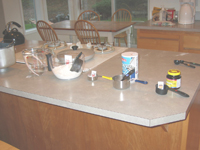
Picture 1: The kitchen counter set up with pre-measured ingredients and the vocabulary next to (or in) each item

Picture 2: Andy and mom are matching the symbols from the object to the worksheet to learn new vocabulary
Ideally, any work like this is done on a slant board. Our counter is not big enough for this. His attention to the material is better if it is slanted and up off the table.
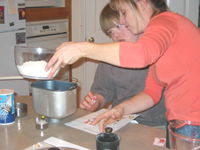
Picture 3: Andy and mom get ready to pour the flour into the breadmaker pan
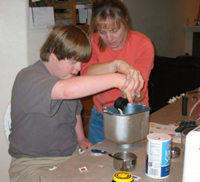
Picture 4: Adding the yeast to the pan
Completed vocabulary checklist
Picture 5 shows the completed "vocabulary checklist". We called it "tools I need" as that is how I organise recipes for folks with developmental disabilities.
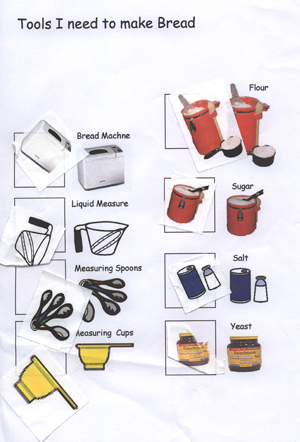
Picture 5: The completed "vocabulary checklist"
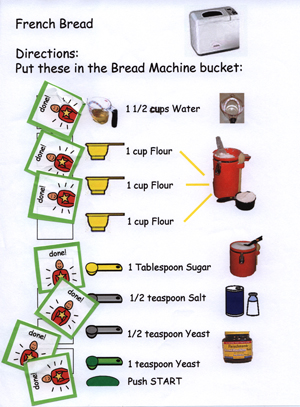
Picture 6: The finished checklist for the recipe (Andy prefers anything other than holding a pen)
Using checklists for directions
The use of a checklist format to follow the steps of an activity is always helpful. Picture 6 shows the checklist that we used for this activity. For this activity, Andy grasped the concept that everything had to be dumped into the pan with no trouble. (See picture 4) This made the checklist cumbersome for that part. I should have had it say, "Put everything in the bread pan" and checked that off as one step.

Picture 7: Putting the pan in the breadmaker (Andy had gotten tired from sitting in a chair where his feet are unsupported, so we moved to the floor)
The next step, we read, is to put the pan in the machine. It would have helped if I had the pan turned the right way! (see picture 7)
Picture 8 shows us playing 'catch up' after putting all the ingredients in the bread machine baking pan.

Picture 8: Playing "catch up"
Push START
Unfortunately, Meagan (Andy's support person) missed him pushing the button due to the delay on the camera, (See picture 9). He did this really well. He slammed the lid down, I pointed to where the start button was located, removed my hands and he pushed it with no correction or second cue. He was very pleased to hear it start up. But we're not quite done....

Picture 9: Pushing the Start button. Here you can see Andy's measuring tape - he's very attracted to tapes. Usually when he is fully engaged in an activity, he puts them down. He uses them as a transition object. At home, we do not fret over the presence of the measuring tape; we merely push it aside or ask him to put it down if we think it is in the way. He is happy to do so, when asked.
Finish checklists
When the bread machine was turned on, we finished our checklists and patted down stickers that weren't completely on the page. (See picture 8). The picture overleaf shows the "tools I need" checklist. It was too cumbersome to get the stickers in the right places earlier. Andy preferred taking the photo out of the food (yeast, flour, etc) and matching that to the sheet, but since these cards were not sticky so they didn't stay put so easily.
What is important for you to note is that:
- In pictures 2 and 8, Andy's eye gaze is on the item to be matched.
- In picture 8, my hand is providing support rather than guidance. Admittedly, there is probably some guidance happening whether I realise it or not either in how the page is being held or with my supporting hand. It is easier to do this without messing up with a slant board. Andy needs assistance getting the sticky part to face the right way.
- In picture 2, there is a hard surface behind the paper.
- Although, we're not using a slant board in these pictures (there wasn't room on the counter), this does makes things a lot easier for Andy.
- If the measuring tape isn't in the way, I did not take it away during this activity. His eye gaze and participation was more important to me than his "looking appropriate." Once he gains a level of familiarity and independence with an activity, the dangly things go away easily. If you look with an eye for participation, Andy is attending to what we're doing (eye gaze, lack of dangling activity, though rope and tape are present).
Finishing the activity for Andy
Once the chores of the activity are over and Andy's had a few minutes to relax (and for me to clean up), we look at the photos in the viewer of the camera and talk about what HE did and how GREAT he is. This is one of Andy's favourite ways to conclude an activity. Then I make a page that tells a brief story about what we just did. They ate the bread later that afternoon; it takes almost 4 hours to bake, (see picture 10). I was at work by then. Photos weren't possible at the time, but I'm told great fun was had by all.

Picture 10: The finished result!
Joan Guthrie Medlen is the author of The Down Syndrome Nutrition Handbook and editor of Disability Solutions, Oregon, USA.

